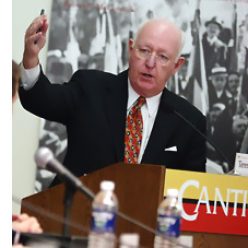Ego Alley and City Dock are looking forlorn these days.
Most of the area is fenced off, crowded with construction equipment and dominated by a huge crane atop a massive barge anchored in the waterway. Even the bronze Alex Haley and his attentive pupils are temporarily out of reach.
The $7.5 million repair and renovation of the inner portion of Ego Alley is underway. Rotting bulkheads are to be rebuilt, sea walls shored up and the electrical connections elevated. The waterfront will look better, but none of this will prevent the frequent flooding of the surrounding streets or deal with the more serious, longer-term threat of sea level rise.
Meanwhile, the City Council is embroiled in another, long-running debate over the zoning changes required to accommodate the latest proposed redevelopment of the shuttered former Fawcetts Boat Supplies store at 110 Compromise Street. Legislation has been submitted to relax the rules governing the Waterfront Marine Conservation District in that area to permit up to 60 per cent of the site to be devoted to non-maritime uses such as restaurants and retail.
As usual, there are opponents and supporters of the proposed changes. I have no dog in this particular fight, but, intrigued by the Waterfront Maritime Conservation concept, I looked up the enabling legislation that was adopted in 1986.
It calls for preservation of …”the maritime industry and historic character” of the City Dock area, which includes 8.43 acres from the Annapolis Yacht Club around Ego Alley to Susan Campbell Park. This is the heart of downtown Annapolis, a high-rent district embracing 16 parcels with an assessed value of $54.4 million.
But exactly what “maritime industry” is there now?
The waiters serving painkillers at Pusser’s Caribbean Grille? The room clerks at the Annapolis Waterfront Hotel? The barflies along Dock Street? Is that “maritime industry?”
“The maritime district concept was flawed from the get-go,” Alderman Ross Arnett told me when I asked what the original idea was. “It was well-intentioned, but they were trying to preserve something that didn’t really exist anymore.”
Indeed, City Dock was once a bustling seaport lined with all kinds of boats and chandleries. But that was a long time ago. Arnett’s main concern today is that if the waterfront conservation standards around Ego Alley are relaxed, property owners in Eastport — his district — will seek the same relief.
Before long, he fears, the genuine maritime businesses that currently line the shores of Eastport, the sail makers and boat builders and the like, will sell out to higher-revenue bars and restaurants and an important element in Annapolis’ maritime character will be lost. At a town hall meeting Thursday night, Arnett said he’d already heard from two Eastport businessmen who want rezoning there as well. Patrick Shaughnessy, president of Farr Yacht Design, spoke up at the meeting to say that he’d been offered better inducements to move his business to France than stay in Annapolis.
Gene Godley, the chairman of the Annapolis Port Wardens, has a broader concern about altering the Waterfront Conservation District zoning to accommodate any one project.
“We need a comprehensive, well-thought-out plan for the entire City Dock area,” he said, “not piecemeal zoning to satisfy one party or another.”
In fact, Annapolis already has such a plan. It is called The Annapolis City Dock Master Plan, drafted by a commission headed by former Baltimore Mayor Kurt Schmoke. Completed in October 2013, with Godley as vice chairman, it was adopted as policy by the City Council.
The Master Plan calls for a thorough re-design of City Dock and Ego Alley, which is where Annapolis meets the water and establishes its identity. It would convert the area from a frequently-flooded parking lot where critics have noted “the cars have the best view of the water,” into a pedestrian-friendly public space that would draw tourists and residents alike. Ward One Alderman Joe Budge said Thursday night that “the real nut to crack” in implementing the City Dock Master plan is “to get the cars out of there.”
Done right, an imaginative City Dock makeover could be a huge asset to the city that both recalls Annapolis’ rich maritime history and enhances the waterfront experience today. Let’s hope that whatever The Council decides respects the Master Plan and helps make the Annapolis inner harbor the welcoming space it can be.
